-
自定义注解
一、Java注解简介
1、Java注解分类
①、JDK基本注解
@Override
重写
@SuppressWarnings(value = “unchecked”)
压制编辑器警告②、JDK元注解
@Retention:定义注解的保留策略
@Retention(RetentionPolicy.SOURCE) //注解仅存在于源码中,在class字节码文件中不包含
@Retention(RetentionPolicy.CLASS) //默认的保留策略,注解会在class字节码文件中存在,但运行时无法获得,
@Retention(RetentionPolicy.RUNTIME) //注解会在class字节码文件中存在,在运行时可以通过反射获取到@Target:指定被修饰的Annotation可以放置的位置(被修饰的目标)
@Target(ElementType.TYPE) //接口、类
@Target(ElementType.FIELD) //属性
@Target(ElementType.METHOD) //方法
@Target(ElementType.PARAMETER) //方法参数
@Target(ElementType.CONSTRUCTOR) //构造函数
@Target(ElementType.LOCAL_VARIABLE) //局部变量
@Target(ElementType.ANNOTATION_TYPE) //注解
@Target(ElementType.PACKAGE) //包
注:可以指定多个位置,例如:
@Target({ElementType.METHOD, ElementType.TYPE}),也就是此注解可以在方法和类上面使用@Inherited:指定被修饰的Annotation将具有继承性
@Documented:指定被修饰的该Annotation可以被javadoc工具提取成文档.
③、自定义注解
注解分类(根据Annotation是否包含成员变量,可以把Annotation分为两类):
标记Annotation:
没有成员变量的Annotation; 这种Annotation仅利用自身的存在与否来提供信息元数据Annotation:
包含成员变量的Annotation; 它们可以接受(和提供)更多的元数据;2、如何自定义注解
使用@interface关键字, 其定义过程与定义接口非常类似, 需要注意的是:
Annotation的成员变量在Annotation定义中是以无参的方法形式来声明的, 其方法名和返回值类型定义了该成员变量的名字和类型,
而且我们还可以使用default关键字为这个成员变量设定默认值;二、自定义注解
1、注解类
①MyAnnotation1
package com.zking.ssm.annotation; import java.lang.annotation.ElementType; import java.lang.annotation.Retention; import java.lang.annotation.RetentionPolicy; import java.lang.annotation.Target; /** * @author xnx * @create 2022-10-27 11:24 */ @Target({ElementType.METHOD,ElementType.TYPE,ElementType.FIELD}) @Retention(RetentionPolicy.RUNTIME) public @interface MyAnnotation1 { // 指的是注解的属性 public String desc() default "desc可以修饰类、属性、方法"; public String value() default "value可以修饰类、属性、方法"; }- 1
- 2
- 3
- 4
- 5
- 6
- 7
- 8
- 9
- 10
- 11
- 12
- 13
- 14
- 15
- 16
- 17
- 18
- 19
②MyAnnotation2
package com.zking.ssm.annotation; import java.lang.annotation.ElementType; import java.lang.annotation.Retention; import java.lang.annotation.RetentionPolicy; import java.lang.annotation.Target; /** * @author xnx * @create 2022-10-27 11:24 */ @Target(ElementType.PARAMETER) @Retention(RetentionPolicy.RUNTIME) public @interface MyAnnotation2 { // 指的是注解的属性 public String desc() default "desc可以修饰类、属性、方法"; public String value() default "value可以修饰类、属性、方法"; }- 1
- 2
- 3
- 4
- 5
- 6
- 7
- 8
- 9
- 10
- 11
- 12
- 13
- 14
- 15
- 16
- 17
- 18
- 19
2、StudentController
package com.zking.ssm.annotation; /** * @author xnx * @create 2022-10-27 11:29 */ @MyAnnotation1(desc = "标记在类上面") public class StudentController { @MyAnnotation1("标记在属性id上面") private String id; @MyAnnotation1("标记在属性name上面") private String name; @MyAnnotation1 public void test1(@MyAnnotation2("标记在参数id中") String id,@MyAnnotation2("标记在参数name中") String name){ System.out.println("测试"); } }- 1
- 2
- 3
- 4
- 5
- 6
- 7
- 8
- 9
- 10
- 11
- 12
- 13
- 14
- 15
- 16
- 17
- 18
- 19
- 20
3、Demo1
package com.zking.ssm.annotation.demo; import com.zking.ssm.annotation.MyAnnotation1; import com.zking.ssm.annotation.MyAnnotation2; import com.zking.ssm.annotation.StudentController; import java.lang.reflect.Field; import java.lang.reflect.Method; import java.lang.reflect.Parameter; /** * @author xnx * @create 2022-10-27 11:37 * * 目标: * 1.获取StudentController 类上自定义注释中的内容 * 2.获取StudentController 方法上自定义注释中的内容 * 3.获取StudentController 属性上自定义注释中的内容 * 4.获取StudentController 参数上自定义注释中的内容 */ public class Demo1 { public static void main(String[] args) throws Exception { // 获得类上自定义注释中的内容 MyAnnotation1 annotation = StudentController.class.getAnnotation(MyAnnotation1.class); System.out.println(annotation.value()); System.out.println(annotation.desc()); // 获得方法上自定义注释中的内容 Method test1 = StudentController.class.getDeclaredMethod("test1", String.class, String.class); MyAnnotation1 m1 = test1.getAnnotation(MyAnnotation1.class); System.out.println(m1.value()); // 获得属性上自定义注释中的内容 Field id = StudentController.class.getDeclaredField("id"); Field name = StudentController.class.getDeclaredField("name"); System.out.println(id.getAnnotation(MyAnnotation1.class).value()); System.out.println(name.getAnnotation(MyAnnotation1.class).value()); // 获得参数上自定义注释中的内容 for (Parameter p : test1.getParameters()) { System.out.println(p.getAnnotation(MyAnnotation2.class).value()); } // Field[] declaredFields = StudentController.class.getDeclaredFields(); // for (Field f : declaredFields) { // MyAnnotation1 annotation1 = f.getAnnotation(MyAnnotation1.class); // if(annotation1 != null){ // // } // } } }- 1
- 2
- 3
- 4
- 5
- 6
- 7
- 8
- 9
- 10
- 11
- 12
- 13
- 14
- 15
- 16
- 17
- 18
- 19
- 20
- 21
- 22
- 23
- 24
- 25
- 26
- 27
- 28
- 29
- 30
- 31
- 32
- 33
- 34
- 35
- 36
- 37
- 38
- 39
- 40
- 41
- 42
- 43
- 44
- 45
- 46
- 47
- 48
- 49
- 50
- 51
- 52
- 53
错误展示:
如图RetentionPolicy应改为RUNTIME
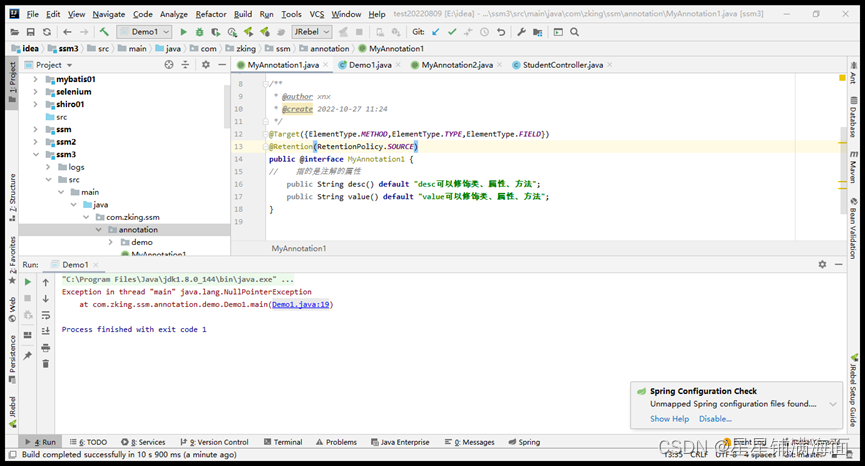
运行效果:
类:
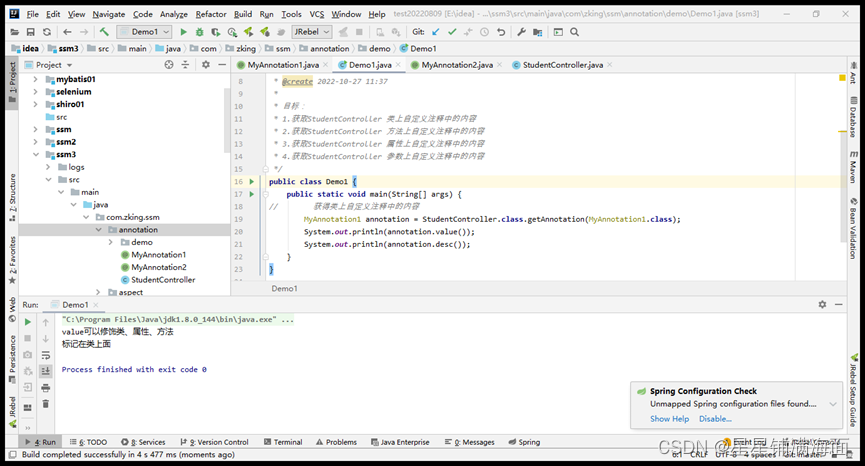
属性:
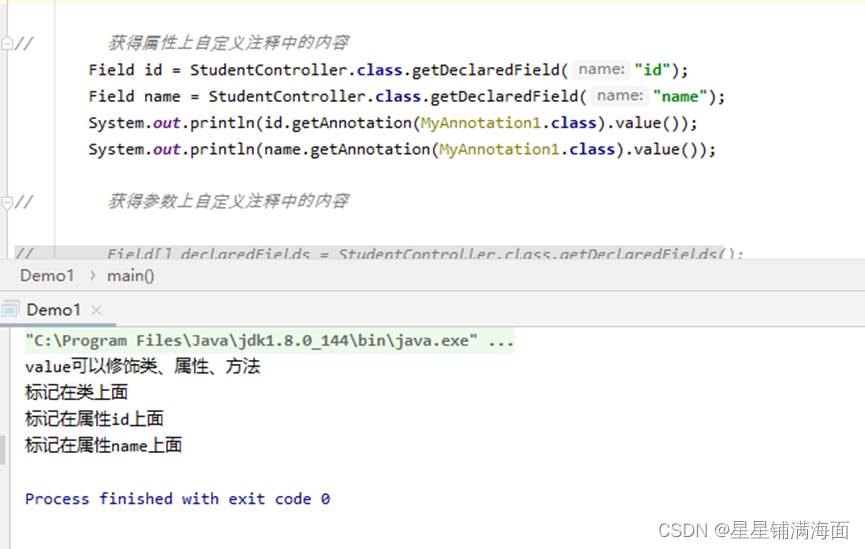
方法:
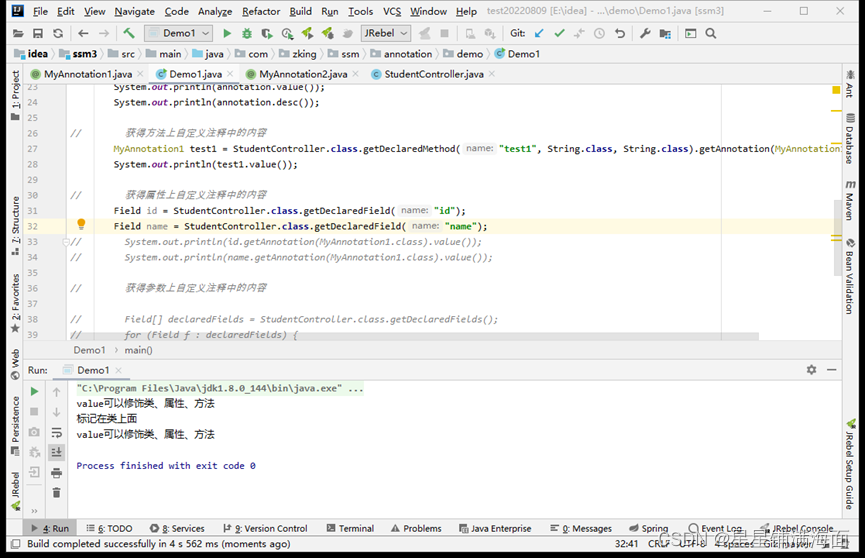
参数:
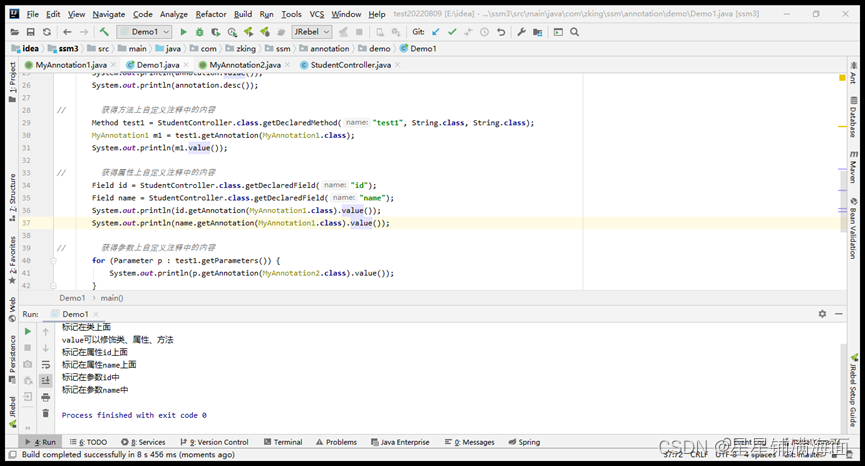
三、Aop自定义注解的应用
自定义注解的介入,可以在使用注解的地方,才触发aop切面
自定义注解日志的使用:1、DemoController
package com.zking.ssm.annotation.aop; import org.springframework.stereotype.Controller; /** * @author xnx * @create 2022-10-27 14:41 */ @Controller public class DemoController { @MyLog(desc = "这是一个测试类的方法") public void test(){ System.out.println("测试方法"); } }- 1
- 2
- 3
- 4
- 5
- 6
- 7
- 8
- 9
- 10
- 11
- 12
- 13
- 14
- 15
- 16
- 17
2、MyLog
package com.zking.ssm.annotation.aop; import java.lang.annotation.ElementType; import java.lang.annotation.Retention; import java.lang.annotation.RetentionPolicy; import java.lang.annotation.Target; /** * @author xnx * @create 2022-10-27 14:40 */ @Target(ElementType.METHOD) @Retention(RetentionPolicy.RUNTIME) public @interface MyLog { String desc(); }- 1
- 2
- 3
- 4
- 5
- 6
- 7
- 8
- 9
- 10
- 11
- 12
- 13
- 14
- 15
- 16
- 17
3、MyLogAspect
package com.zking.ssm.annotation.aop; import org.aspectj.lang.JoinPoint; import org.aspectj.lang.annotation.Aspect; import org.aspectj.lang.annotation.Before; import org.aspectj.lang.annotation.Pointcut; import org.aspectj.lang.reflect.MethodSignature; import org.slf4j.Logger; import org.slf4j.LoggerFactory; import org.springframework.stereotype.Component; /** * @author xnx * @create 2022-10-27 14:44 */ @Component @Aspect public class MyLogAspect { private static final Logger logger = LoggerFactory.getLogger(MyLogAspect.class); /** * 只要用到了com.javaxl.p2.annotation.springAop.MyLog这个注解的,就是目标类 */ @Pointcut("@annotation(com.zking.ssm.annotation.aop.MyLog)") private void MyValid() { } @Before("MyValid()") public void before(JoinPoint joinPoint) { MethodSignature signature = (MethodSignature) joinPoint.getSignature(); logger.debug("[" + signature.getName() + " : start.....]"); System.out.println("[" + signature.getName() + " : start.....]"); MyLog myLog = signature.getMethod().getAnnotation(MyLog.class); logger.debug("【目标对象方法被调用时候产生的日志,记录到日志表中】:"+myLog.desc()); System.out.println("【目标对象方法被调用时候产生的日志,记录到日志表中】:" + myLog.desc()); } }- 1
- 2
- 3
- 4
- 5
- 6
- 7
- 8
- 9
- 10
- 11
- 12
- 13
- 14
- 15
- 16
- 17
- 18
- 19
- 20
- 21
- 22
- 23
- 24
- 25
- 26
- 27
- 28
- 29
- 30
- 31
- 32
- 33
- 34
- 35
- 36
- 37
- 38
- 39
4、AnnotationTest
package com.zking.shiro; import com.zking.ssm.annotation.aop.DemoController; import com.zking.ssm.biz.ClazzBiz; import org.junit.Test; import org.junit.runner.RunWith; import org.springframework.beans.factory.annotation.Autowired; import org.springframework.test.context.ContextConfiguration; import org.springframework.test.context.junit4.SpringJUnit4ClassRunner; @RunWith(SpringJUnit4ClassRunner.class) @ContextConfiguration(locations={"classpath:applicationContext.xml"}) public class AnnotationTest { @Autowired private DemoController demoController; @Test public void test1(){ demoController.test(); } }- 1
- 2
- 3
- 4
- 5
- 6
- 7
- 8
- 9
- 10
- 11
- 12
- 13
- 14
- 15
- 16
- 17
- 18
- 19
- 20
- 21
- 22
- 23
- 24
运行效果:
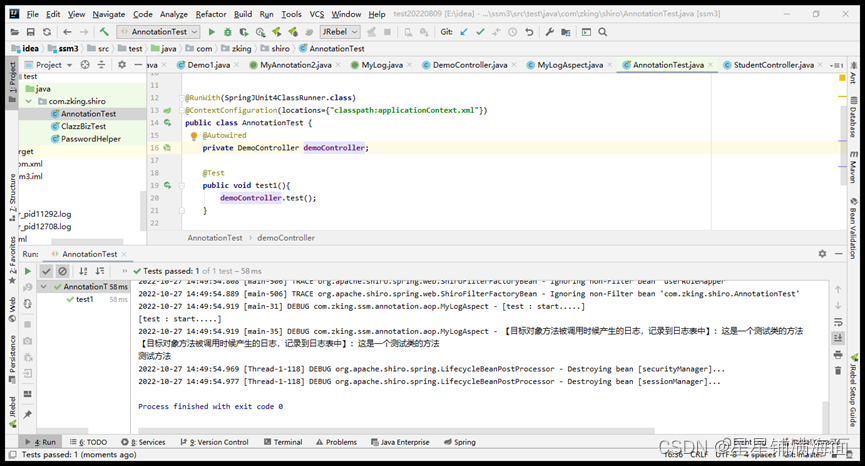
-
相关阅读:
Yakit工具篇:中间人攻击(平替Burp)的相关技巧-01
【面试经典150题】 O(1) 时间插入、删除和获取随机元素 JavaScript
在Plesk中如何开启https
嵌入式摄像头,获取视频要通过进程通讯?
About 11.13 This Week
Go 结构体深度探索:从基础到应用
前后端分离
docker介绍、安装及卸载
(十一)React Ant Design Pro + .Net5 WebApi:后端环境搭建-IdentityServer4(三)持久化
linux线程详解:线程概念、线程调度、线程安全、线程模型
- 原文地址:https://blog.csdn.net/weixin_67677668/article/details/127551535
